Citroen C5 2017 (RD/TD) / 2.G Owner's Manual
Manufacturer: CITROEN, Model Year: 2017, Model line: C5, Model: Citroen C5 2017 (RD/TD) / 2.GPages: 348, PDF Size: 10.72 MB
Page 201 of 348
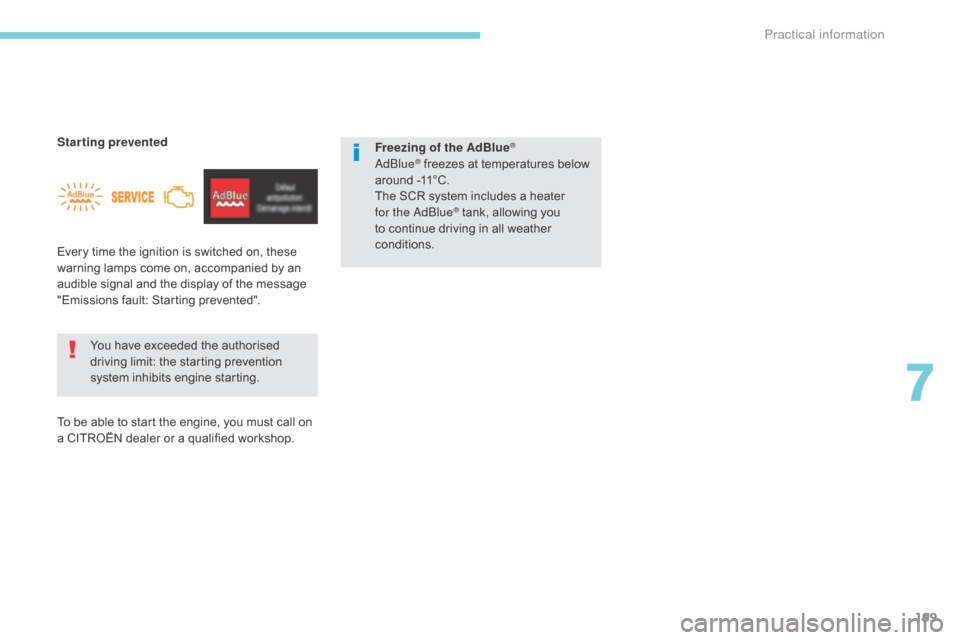
199
C5_en_Chap07_info-pratiques_ed01-2016
Every time the ignition is switched on, these
warning lamps come on, accompanied by an
audible signal and the display of the message
"Emissions fault: Starting prevented".You have exceeded the authorised
driving limit: the starting prevention
system inhibits engine starting. Freezing of the AdBlue
®
AdBlue® freezes at temperatures below
around -11°C.
The SCR system includes a heater
for the AdBlue
® tank, allowing you
to continue driving in all weather
conditions.
Starting prevented
To be able to start the engine, you must call on
a CITROËN dealer or a qualified workshop.
7
Practical information
Page 202 of 348
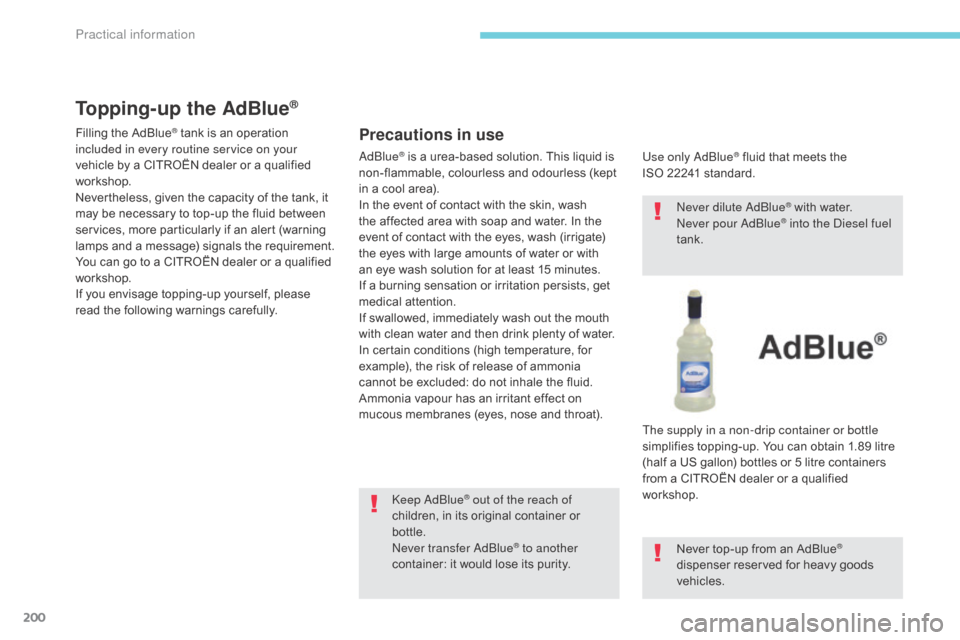
200
C5_en_Chap07_info-pratiques_ed01-2016
Precautions in use
AdBlue® is a urea-based solution. This liquid is
non-flammable, colourless and odourless (kept
in a cool area).
In the event of contact with the skin, wash
the affected area with soap and water. In the
event of contact with the eyes, wash (irrigate)
the eyes with large amounts of water or with
an eye wash solution for at least 15 minutes.
If a burning sensation or irritation persists, get
medical attention.
If swallowed, immediately wash out the mouth
with clean water and then drink plenty of water.
In certain conditions (high temperature, for
example), the risk of release of ammonia
cannot be excluded: do not inhale the fluid.
Ammonia vapour has an irritant effect on
mucous membranes (eyes, nose and throat).
Keep AdBlue
® out of the reach of
children, in its original container or
bottle.
Never transfer AdBlue
® to another
container: it would lose its purity. Use only AdBlue
® fluid that meets the
ISO
22241 standard.
Never dilute AdBlue
® with water.
Never pour AdBlue® into the Diesel fuel
tank.
The supply in a non-drip container or bottle
simplifies topping-up. You can obtain 1.89 litre
(half a US gallon) bottles or 5 litre containers
from a CITROËN
dealer or a qualified
workshop.
Never top-up from an AdBlue
®
dispenser reserved for heavy goods
vehicles.
Topping-up the AdBlue®
Filling the AdBlue® tank is an operation
included in every routine service on your
vehicle by a CITROËN dealer or a qualified
workshop.
Nevertheless, given the capacity of the tank, it
may be necessary to top-up the fluid between
services, more particularly if an alert (warning
lamps and a message) signals the requirement.
You can go to a CITROËN dealer or a qualified
workshop.
If you envisage topping-up yourself, please
read the following warnings carefully.
Practical information
Page 203 of 348
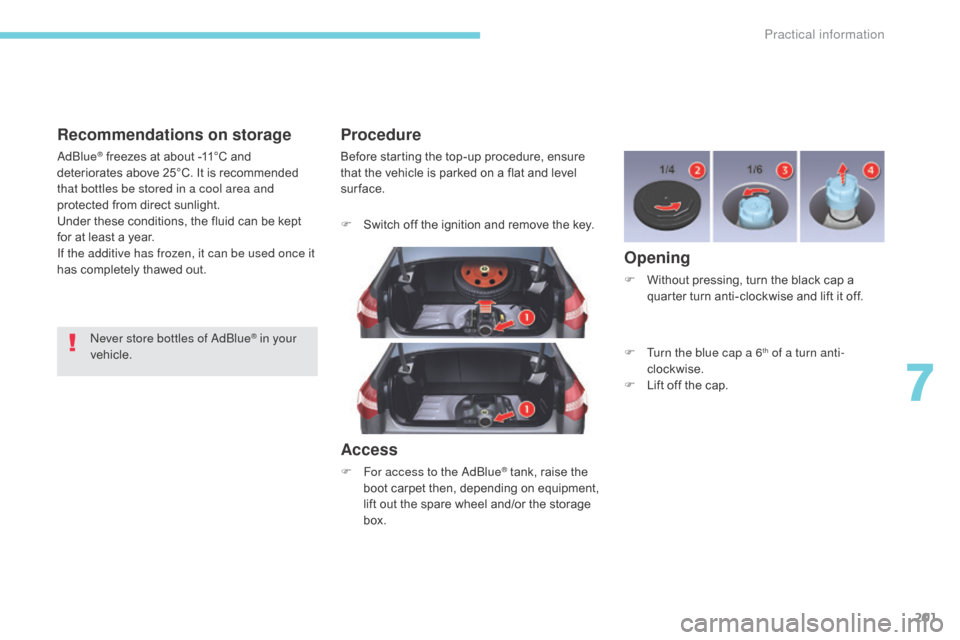
201
C5_en_Chap07_info-pratiques_ed01-2016
Recommendations on storage
AdBlue® freezes at about -11°C and
deteriorates above 25°C. It is recommended
that bottles be stored in a cool area and
protected from direct sunlight.
Under these conditions, the fluid can be kept
for at least a year.
If the additive has frozen, it can be used once it
has completely thawed out.
Never store bottles of AdBlue
® in your
vehicle.
Procedure
Before starting the top-up procedure, ensure
that the vehicle is parked on a flat and level
sur face.
F
S
witch off the ignition and remove the key.
Access
F For access to the AdBlue® tank, raise the
boot carpet then, depending on equipment,
lift out the spare wheel and/or the storage
box.
Opening
F Without pressing, turn the black cap a quarter turn anti-clockwise and lift it off.
F
T
urn the blue cap a 6
th of a turn anti-
clockwise.
F
L
ift off the cap.
7
Practical information
Page 204 of 348
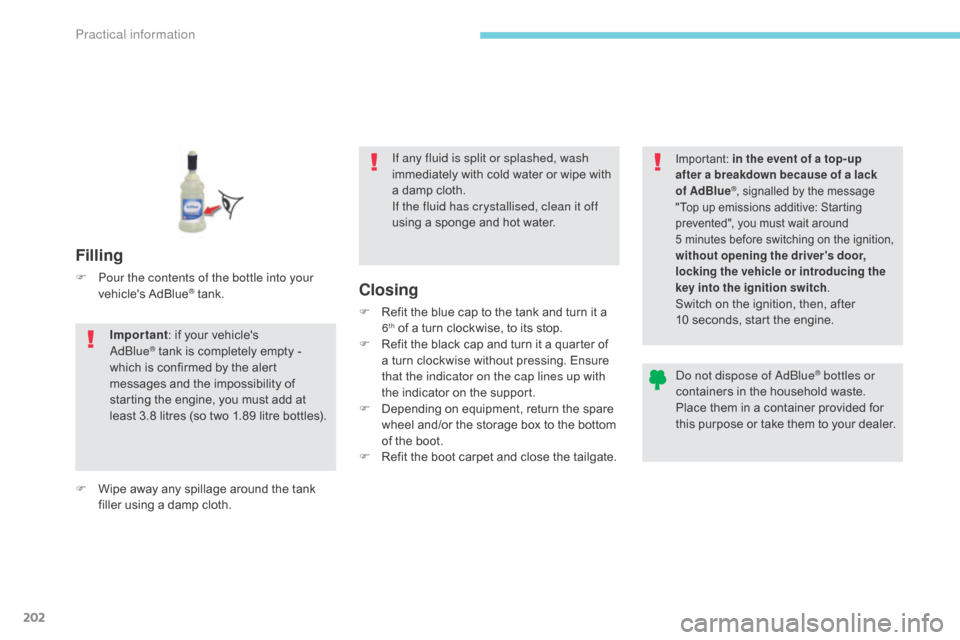
202
C5_en_Chap07_info-pratiques_ed01-2016
Closing
F Refit the blue cap to the tank and turn it a 6th of a turn clockwise, to its stop.
F
R
efit the black cap and turn it a quarter of
a turn clockwise without pressing. Ensure
that the indicator on the cap lines up with
the indicator on the support.
F
D
epending on equipment, return the spare
wheel and/or the storage box to the bottom
of the boot.
F
R
efit the boot carpet and close the tailgate.
Important: in the event of a top-up
after a breakdown because of a lack
of AdBlue
®, signalled by the message
"Top up emissions additive: Starting
prevented", you must wait around
5
minutes before switching on the ignition,
without opening the driver's door,
locking the vehicle or introducing the
key into the ignition switch .
Switch on the ignition, then, after
10
seconds, start the engine.
Do not dispose of AdBlue
® bottles or
containers in the household waste.
Place them in a container provided for
this purpose or take them to your dealer.
If any fluid is split or splashed, wash
immediately with cold water or wipe with
a damp cloth.
If the fluid has crystallised, clean it off
using a sponge and hot water.
F
W
ipe away any spillage around the tank
filler using a damp cloth. Important
: if your vehicle's
AdBlue
® tank is completely empty -
w
hich is confirmed by the alert
messages and the impossibility of
starting the engine, you must add at
least 3.8 litres (so two 1.89 litre bottles).
Filling
F Pour the contents of the bottle into your vehicle's AdBlue® tank.
Practical information
Page 205 of 348

203
C5_en_Chap08_en-cas-de-panne_ed01-2016
HDi engines make use of advanced
technology.
For any work on your vehicle, contact
a qualified workshop that has the
skills and equipment required, which a
CITROËN dealer is able to provide.
BlueHDi engines
Running out of fuel (Diesel)
Priming the fuel system
HDi 160 engine
If you run out of fuel:
F a fter filling (minimum 5 litres) and removing
the protective cover to gain access to the
priming pump,
F
o
perate the manual priming pump, until
some resistance is felt,
F
o
perate the starter motor while depressing
the accelerator pedal slightly until the
engine starts. If the engine fails to start at the first attempt,
wait fifteen seconds before trying again.
If the engine fails to start after a few attempts,
operate the priming pump again and then try to
start the engine.
When the engine is idling, accelerate slightly to
complete the bleeding of the circuit.
F
F ill the fuel tank with at least 5 litres of
Diesel.
F
S
witch on the ignition (without starting the
engine).
F
W
ait around 6 seconds and switch off the
ignition.
F
R
epeat the operation 10 times.
F
O
perate the starter to run the engine.
8
In the event of a breakdown
Page 206 of 348
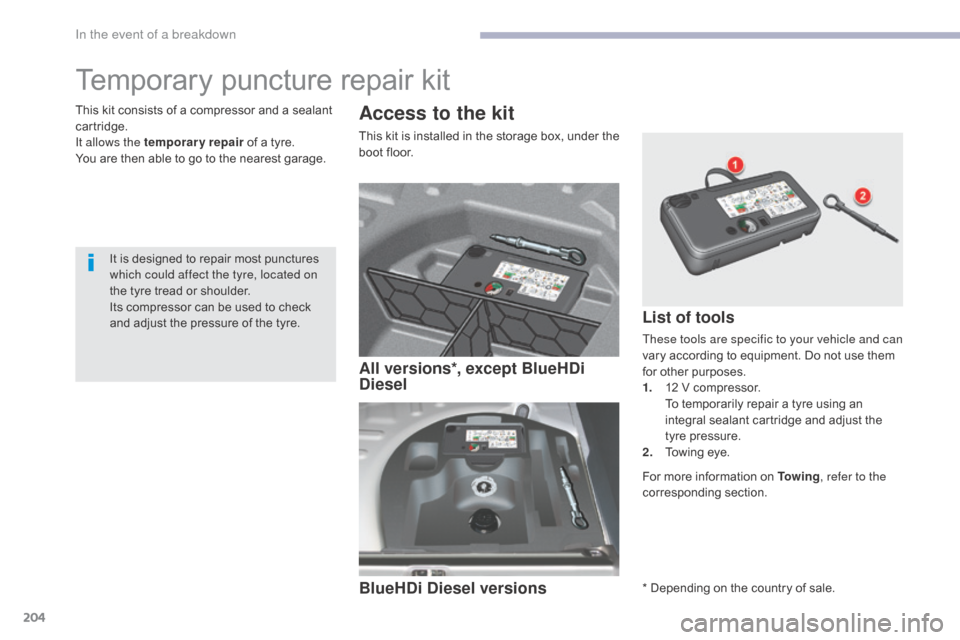
204
C5_en_Chap08_en-cas-de-panne_ed01-2016
Temporary puncture repair kit
Access to the kit
This kit is installed in the storage box, under the
boot floor.
This kit consists of a compressor and a sealant
cartridge.
It allows the temporary repair
of a tyre.
You are then able to go to the nearest garage.
It is designed to repair most punctures
which could affect the tyre, located on
the tyre tread or shoulder.
Its compressor can be used to check
and adjust the pressure of the tyre.
List of tools
These tools are specific to your vehicle and can
vary according to equipment. Do not use them
for other purposes.
1.
1
2 V compressor.
T
o temporarily repair a tyre using an
integral sealant cartridge and adjust the
tyre pressure.
2.
T
owing eye.
For more information on To w i n g , refer to the
corresponding section.
All versions*, except BlueHDi
Diesel
BlueHDi Diesel versions
* Depending on the country of sale.
In the event of a breakdown
Page 207 of 348
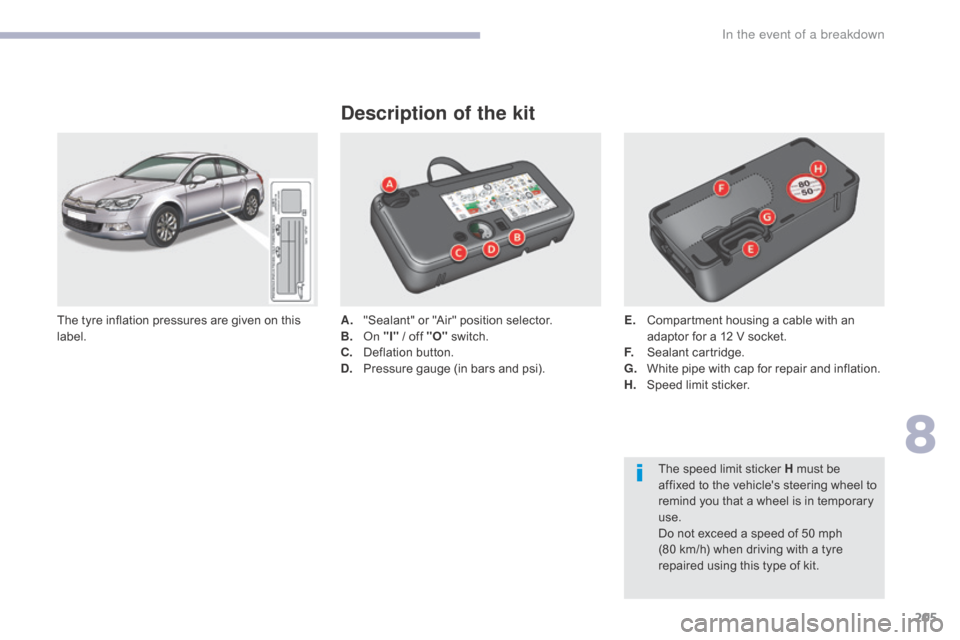
205
C5_en_Chap08_en-cas-de-panne_ed01-2016
Description of the kit
A. "Sealant" or "Air" position selector.
B. On "I" / off "O" switch.
C.
D
eflation button.
D.
P
ressure gauge (in bars and psi). E. C
ompartment housing a cable with an
adaptor for a 12 V socket.
F.
S
ealant cartridge.
G.
W
hite pipe with cap for repair and inflation.
H.
S
peed limit sticker.
The speed limit sticker H must be
affixed to the vehicle's steering wheel to
remind you that a wheel is in temporary
use.
Do not exceed a speed of 50 mph
(80
km/h) when driving with a tyre
repaired using this type of kit.
The tyre inflation pressures are given on this
label.
8
In the event of a breakdown
Page 208 of 348

206
C5_en_Chap08_en-cas-de-panne_ed01-2016
Repair procedure
1. Sealing
F Switch off the ignition.
F
T
urn the selector A to the
"sealant" position.
F
C
heck that the switch B is in
position "O" .
Avoid removing any foreign bodies
which have penetrated into the tyre. F
U ncoil the white pipe G fully.
F U nscrew the cap from the white pipe.
F
C
onnect the white pipe to the valve of the
tyre to be repaired.
Take care, this product is harmful if
swallowed and causes irritation to the eyes.
Keep this product out of the reach of
children.
F Connect the compressor's electric plug to the vehicle's 12 V socket.
F
S
tart the vehicle and leave the engine
running.
Do not start the compressor before
connecting the white pipe to the tyre
valve: the sealant product would be
expelled through the pipe.
In the event of a breakdown
Page 209 of 348

207
C5_en_Chap08_en-cas-de-panne_ed01-2016
F Switch on the compressor by moving the switch B to position "I" until the tyre
pressure reaches 2.0 bars.
T
he sealant is injected into the tyre under
pressure; do not disconnect the pipe from
the valve during this operation (risk of
splashing). F
R emove the kit and screw the cap back on
the white pipe.
T
ake care to avoid staining your vehicle
with traces of fluid. Keep the kit to hand.
F
D
rive immediately for approximately
three miles (five kilometres), at reduced
speed (between 12 and 37 mph (20 and
60
km/h)), to plug the puncture.
F
S
top to check the repair and the tyre
pressure using the kit.
If after around 5 to 7 minutes the
pressure is not attained, this indicates
that the tyre is not repairable; contact
a CITROËN dealer or a qualified
workshop for assistance.
8
In the event of a breakdown
Page 210 of 348
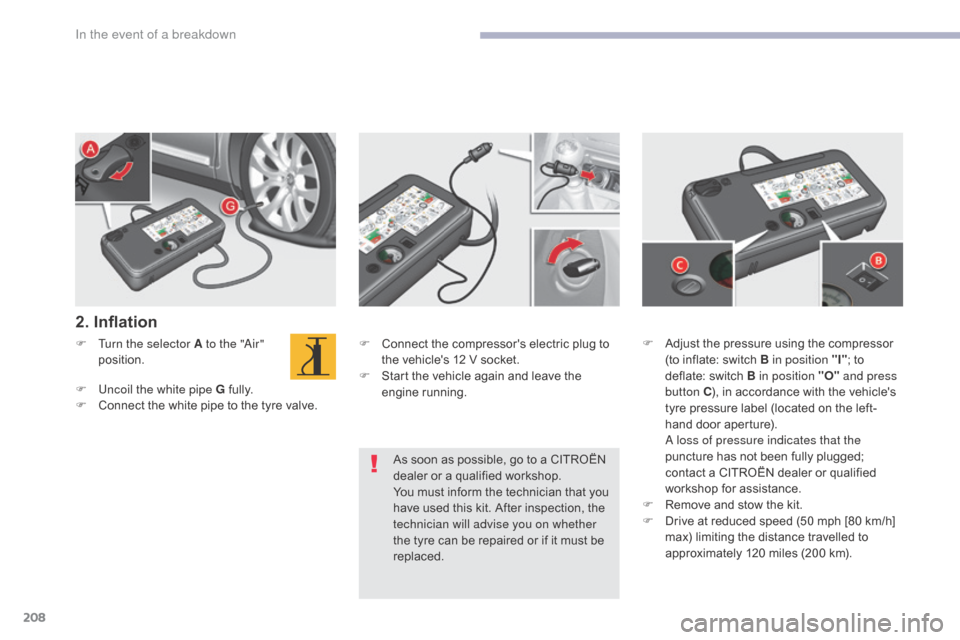
208
C5_en_Chap08_en-cas-de-panne_ed01-2016
2. Inflation
F Turn the selector A to the "Air" position.
F
U
ncoil the white pipe G fully.
F
C
onnect the white pipe to the tyre valve. F
C onnect the compressor's electric plug to
the vehicle's 12 V socket.
F
S
tart the vehicle again and leave the
engine running.
As soon as possible, go to a CITROËN
dealer or a qualified workshop.
You must inform the technician that you
have used this kit. After inspection, the
technician will advise you on whether
the tyre can be repaired or if it must be
replaced. F
A djust the pressure using the compressor
(to inflate: switch B in position "I" ; to
deflate: switch B in position "O" and press
button C ), in accordance with the vehicle's
tyre pressure label (located on the left-
hand door aperture).
A l
oss of pressure indicates that the
puncture has not been fully plugged;
contact a CITROËN dealer or qualified
workshop for assistance.
F
R
emove and stow the kit.
F
D
rive at reduced speed (50 mph [80 km/h]
max) limiting the distance travelled to
approximately 120 miles (200 km).
In the event of a breakdown